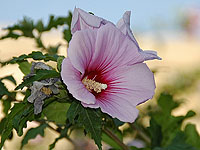 |
|
Uzbekistan - General Information |
||||
|
Protection of soil. Until recently the country's agriculture was adjusted to a single sector: the cotton growing. It has resulted in the serious deterioration of soil. Saline land area is about 2 million hectares. Preventing the soil from over salinity is one of the main problems. Water and wind erosion also deteriorates the quality of soil. In recent years numerous measures have been undertaken to protect the soil and improve its quality. In particular, various types of plants have been planted on a 1,7 thousand-hectare land area, the quality of 2.4 thousand-hectare of land was improved and 600 thousand-hectare of mountain and foothill platforms were formed. Protection of flora. All the natural zones of Uzbekistan - deserts, plains, foothills and mountains are covered with different sorts of plants, There are a variety of many plants and 10-12 percent of them need protection. For different reasons reeds along riverbanks have started to decline and conditions of meadows have worsened. Rapid urbanization, widening of automobile and train routes has significantly added to this problem. Protection of fauna. For the past decades the fauna of the country has been considerably damaged by intensive economic-industrial activities. Some species are on the brink of extinction. In the second half of the last century there was a great number of leopards, tigers, Bukhara mountain sheep, red wolves, and Tian Shan white bears in the mountain areas of the country. By now many of them have disappeared. Developing economic activities in desert areas has resulted in the extinction of many species living in these places. According to current statistics, the Central Asian leopard, the Usturt sheep, Central Asian cobra, Central Asian sable, spotted lizard, swan, spotted boa, and golden eagle are on the brink of extinction. Reserves. There are a number of reserves and national parks in the country. Now there are 11 protected natural zones and one ecological center, namely "Jayran" in the country. The total area of reserves is two million hectares, which includes nine in Chatkal mountain ranges, Paighambar Island, Nurata, Tugay, Zarafshan, Ghyssar, Vardanzy, Kitab, Kyzyl Kum, Badai, and Kughitan. There are also 10 reserves in the country. Protection of landscape, historical and natural monuments. The State Nature Protection Committee, established in late 80s, has taken more than 400 natural monuments under its protection. Only 80 of them are monuments of a so-cailed inanimate nature. It includes various karst relief, springs, and waterfalls. There are a number of institutions of the Uzbek Academy of Science including the Institute of Botany, Institute of Zoology, Institute of Geology, Institute of Soil Science and Agricultural Chemistry, and other educational-research bodies dealing with issues of ecology. The International Fund on Ecology and Sanitation - "Ecosan" has been established in 1991. Uzbekistan is taking an active part in various international programs and projects on ecology and nature protection. For instance, in 1992 Uzbekistan was among 178 countries, which participated in the UN Conference in Rio-de-Janeiro on Environment and Development. The country has fully committed itself upon the UN obligation on sustainable development. The Government of Uzbekistan pays much attention in environmental issues and problems of the rational exploitation of natural resources. To this effect, a number of legislative documents have been passed. The State Program on environmental protection until 2005 is now being successfully implemented. |


